A Systematic Literature Review on the User Experience Design for Game-Based Interventions via 3D Virtual Worlds in K-12 Education
Abstract
:1. Introduction
2. Related Work
2.1. Knowledge Acquisition and Skill Training in Game-Based Learning Settings
2.2. Gameplay and Game Mechanics
- Learning objectives: Educational games are designed with a specific purpose in mind and clearly defined learning goals aligned to the needs of the learning subject in consideration.
- Specific instructions and rules: Predefined rules and boundaries so as to prevent the development of misconceptions.
- Interactivity: The essence of (educational) games relies on the active involvement of (learners) players in achieving specific goals and objectives. Therein, diverse opportunities for decisions and actions should be offered during the engagement time.
- Feedback: The game should have predefined reinforcement (positive, negative) mechanisms (e.g., award, punishment) to compliment the actions of the engaged players.
- Challenge: Every challenge has to do with uncertainty on specific goal achievements, hidden information, and multiple levels of difficulty. The degree of challenges should be proportional to the level and potential of players which support (or not) directly their actions.
3. Materials and Methods
3.1. Rationale and Research Questions
- RQ1: What is the most frequent set of learning and game mechanics adopted in game prototypes?
- RQ2: What in-game events and trends are of great interest to instructional designers for effective teaching interventions?
- RQ3: What elements and underpinning attributes were provided as the most crucial for students to be cognitively and emotionally engaged in educational gameplay within different instructional settings?
- RQ4: What research methods and data collection instruments were utilized to measure cognitive, affective, and behavioral aspects of learning?
3.2. Search Strategy
3.3. Study Search and Selection Criteria
3.4. Collection of Unbiased Studies
3.5. Study Quality Assessment
4. Results
4.1. Learning and Game Mechanics (RQ1: What Is the Most Frequent Set of Learning and Game Mechanics Adopted in Game Prototypes?)
4.2. Game Events and Trends (RQ2: What In-Game Events and Trends Are of Great Interest to Instructional Designers for Effective Teaching Interventions?)
4.3. Design Elements (RQ3: What Elements and Underpinning Attributes Were Provided as the Most Crucial for Students to Be Cognitively and Emotionally Engaged in Educational Gameplay within Different Instructional Settings?)
4.4. Research Designs (RQ4: What Research Methods and Data Collection Instruments Were Utilized to Measure Cognitive, Affective, and Behavioral Aspects of Learning?)
5. Discussion and Conclusions
6. Limitations and Future Work
Supplementary Materials
Author Contributions
Funding
Conflicts of Interest
References
- Pellas, N.; Vosinakis, S. The effect of simulation games on learning computer programming: A comparative study on high school students’ learning performance by assessing computational problem-solving strategies. Educ. Inf. Technol. 2018, 23, 2423–2452. [Google Scholar] [CrossRef]
- Gee, J.P. Good Video Games and Good Learning; Peter Lang: Frankfurt am Main, Germany, 2007. [Google Scholar]
- Prensky, M. Digital game-based learning. Comput. Entertain. 2003, 1, 21. [Google Scholar] [CrossRef]
- Pellas, N.; Mystakidis, S. A systematic review of research about game-based learning in virtual worlds. Special Issue: “Ex-ploring Immersive Technologies in Learning”. J. Univ. Comput. Sci. 2020, 26, 1017–1042. [Google Scholar]
- Pellas, N. Exploring interrelationships among high school students’ engagement factors in introductory programming courses via a 3D multi-user serious game created in OpenSim. J. Univ. Comput. Sci. 2014, 20, 1608–1628. [Google Scholar] [CrossRef]
- Pellas, N.; Peroutseas, E. Gaming in Second Life via Scratch4SL. J. Educ. Comput. Res. 2016, 54, 108–143. [Google Scholar] [CrossRef]
- Dalgarno, B.; Lee, M.J.W. What are the learning affordances of 3-D virtual environments? Br. J. Educ. Technol. 2009, 41, 10–32. [Google Scholar] [CrossRef]
- Barab, S.; Thomas, M.; Dodge, T.; Carteaux, R.; Tuzun, H. Making learning fun: Quest Atlantis, a game without guns. Educ. Technol. Res. Dev. 2005, 53, 86–107. [Google Scholar] [CrossRef] [Green Version]
- Fokides, E.; Chachlaki, F. 3D Multiuser Virtual Environments and Environmental Education: The Virtual Island of the Mediterranean Monk Seal. Technol. Knowl. Learn. 2019, 25, 1–24. [Google Scholar] [CrossRef]
- Kamarainen, A.M.; Metcalf, S.; Grotzer, T.; DeDe, C. Exploring Ecosystems from the Inside: How Immersive Multi-user Virtual Environments Can Support Development of Epistemologically Grounded Modeling Practices in Ecosystem Science Instruction. J. Sci. Educ. Technol. 2014, 24, 148–167. [Google Scholar] [CrossRef] [Green Version]
- Lim, C.P.; Nonis, D.; Hedberg, J. Gaming in a 3D multiuser virtual environment: engaging students in Science lessons. Br. J. Educ. Technol. 2006, 37, 211–231. [Google Scholar] [CrossRef]
- Battal, A.; Tokel, S.T. Investigating the Factors Affecting Students’ Satisfaction in a Programming Course Designed in 3D Virtual Worlds. Turk. Online J. Qual. Inq. 2020, 11, 218–246. [Google Scholar] [CrossRef]
- Jakoš, F.; Verber, D. Learning Basic Programing Skills with Educational Games. J. Educ. Comput. Res. 2017, 55, 673–698. [Google Scholar] [CrossRef]
- Kim, H.; Ke, F. Effects of game-based learning in an OpenSim-supported virtual environment on mathematical performance. Interact. Learn. Environ. 2017, 25, 543–557. [Google Scholar] [CrossRef]
- Merchant, G. 3D virtual worlds as environments for literacy learning. Educ. Res. 2010, 52, 135–150. [Google Scholar] [CrossRef] [Green Version]
- Mystakidis, S.; Berki, E. The Case of Literacy Motivation: Playful 3D immersive learning environments and problem-focused education for blended digital storytelling. Int. J. Web-Based Learn. Teach. Technol. 2018, 13, 64–79. [Google Scholar] [CrossRef] [Green Version]
- Yeh, Y.-L.; Lan, Y.-J. Fostering student autonomy in English learning through creations in a 3D virtual world. Educ. Technol. Res. Dev. 2017, 66, 693–708. [Google Scholar] [CrossRef]
- Tüzün, H. Blending video games with learning: Issues and challenges with classroom implementations in the Turkish context. Br. J. Educ. Technol. 2007, 38, 465–477. [Google Scholar] [CrossRef]
- Wang, X.; Xing, W.; Laffey, J.M. Autistic youth in 3D game-based collaborative virtual learning: Associating avatar interaction patterns with embodied social presence. Br. J. Educ. Technol. 2018, 49, 742–760. [Google Scholar] [CrossRef]
- Barab, S.; Pettyjohn, P.; Gresalfi, M.; Volk, C.; Solomou, M. Game-based curriculum and transformational play: Designing to meaningfully positioning person, content, and context. Comput. Educ. 2012, 58, 518–533. [Google Scholar] [CrossRef]
- Dede, C.; Grotzer, T.A.; Kamarainen, A.; Metcalf, S. EcoXPT: Designing for Deeper Learning through Experimentation in an Immersive Virtual Ecosystem. Educ. Tech. Soc. 2017, 20, 166–178. [Google Scholar]
- Jacobson, M.J.; Taylor, C.E.; Richards, D. Computational scientific inquiry with virtual worlds and agent-based models: new ways of doing science to learn science. Interact. Learn. Environ. 2015, 24, 2080–2108. [Google Scholar] [CrossRef] [Green Version]
- Grotzer, T.A.; Kamarainen, A.M.; Tutwiler, M.S.; Metcalf, S.; DeDe, C. Learning to Reason about Ecosystems Dynamics over Time: The Challenges of an Event-Based Causal Focus. BioScience. 2013, 63, 288–296. [Google Scholar] [CrossRef] [Green Version]
- Ketelhut, D.J. The Impact of Student Self-efficacy on Scientific Inquiry Skills: An Exploratory Investigation in River City, a Multi-user Virtual Environment. J. Sci. Educ. Technol. 2007, 16, 99–111. [Google Scholar] [CrossRef] [Green Version]
- Loula, A.C.; De Castro, L.N.; Da Rocha, P.L.B.; Carneiro, M.D.C.L.; Reis, V.P.G.S.; Machado, R.F.; Sepúlveda, C.; Apolinario, A.L.; El-Hani, C.N. Modeling a Virtual World for the Educational Game Calangos. Int. J. Comput. Games Technol. 2014, 2014, 1–14. [Google Scholar] [CrossRef] [Green Version]
- Metcalf, S.J.; Reilly, J.M.; Kamarainen, A.M.; King, J.; Grotzer, T.A.; Dede, C. Supports for deeper learning of inquiry-based ecosystem science in virtual environments—Comparing virtual and physical concept mapping. Comput. Hum. Behav. 2018, 87, 459–469. [Google Scholar] [CrossRef]
- Moon, J.; Ke, F.; Sokolikj, Z. Automatic assessment of cognitive and emotional states in virtual reality-based flexibility training for four adolescents with autism. Br. J. Educ. Technol. 2020, 51, 1766–1784. [Google Scholar] [CrossRef]
- Nelson, B.C. Exploring the Use of Individualized, Reflective Guidance in an Educational Multi-User Virtual Environment. J. Sci. Educ. Technol. 2006, 16, 83–97. [Google Scholar] [CrossRef] [Green Version]
- Twining, P. Exploring the educational potential of virtual worlds-Some reflections from the SPP. Br. J. Educ. Technol. 2009, 40, 496–514. [Google Scholar] [CrossRef]
- Şimşek, I. The effect of 3D virtual learning environment on secondary school third grade students’ attitudes toward mathe-matics. Turk. Online J. Educ. Tech. 2016, 15, 162–168. Available online: https://files.eric.ed.gov/fulltext/EJ1106361.pdf (accessed on 10 March 2021).
- Rico, M.; Martínez-Muñoz, G.; Alaman, X.; Camacho, D.; Pulido, E. Improving the programming experience of high school students by means of virtual worlds. Int. J. Eng. Educ. 2011, 27, 52–60. [Google Scholar]
- Pellas, N. An exploration of interrelationships among presence indicators of a community of inquiry in a 3D game-like environment for high school programming courses. Interact. Learn. Environ. 2016, 25, 1–18. [Google Scholar] [CrossRef]
- Zheng, D.; Young, M.F.; Wagner, M.M.; Brewer, R.A. Negotiation for Action: English Language Learning in Game-Based Virtual Worlds. Mod. Lang. J. 2009, 93, 489–511. [Google Scholar] [CrossRef]
- Young, W.; Franklin, T.; Cooper, T.; Carroll, S.; Liu, C. Game-based learning aids in Second Life. J. Interact. Learn. Res. 2012, 23, 57–80. [Google Scholar]
- Liaw, S.Y.; Carpio, G.A.C.; Lau, Y.; Tan, S.C.; Lim, W.S.; Goh, P.S. Multiuser virtual worlds in healthcare education: A systematic review. Nurse Educ. Today 2018, 65, 136–149. [Google Scholar] [CrossRef]
- Ghanbarzadeh, R.; Ghapanchi, A.H. Investigating various application areas of three-dimensional virtual worlds for higher education. Br. J. Educ. Technol. 2016, 49, 370–384. [Google Scholar] [CrossRef]
- De Freitas, S. Are Games Effective Learning Tools? A Review of Educational Games. Educ. Technol. Soc. 2018, 21, 74–84. [Google Scholar]
- Wouters, P.; van Nimwegen, C.; van Oostendorp, H.; van der Spek, E.D. A meta-analysis of the cognitive and motivation-al effects of serious games. J. Educ. Psych. 2013, 105, 249–265. [Google Scholar] [CrossRef] [Green Version]
- Connolly, T.M.; Boyle, E.A.; MacArthur, E.; Hainey, T.; Boyle, J.M. A systematic literature review of empirical evi-dence on computer games and serious games. Comput. Educ. 2012, 59, 661–686. [Google Scholar] [CrossRef]
- Herz, J.C. Joystick Nation: How Videogames Ate Our Quarters, Won Our Hearts, and Rewired Our Minds; Little, Brown and Company: Boston, MA, USA, 1997. [Google Scholar]
- Salen, K.; Zimmerman, E. Rules of Play: Game Design Fundamentals; MIT press: Cambridge, MA, USA, 2004. [Google Scholar]
- Fabricatore, C. Gameplay and game mechanics: A key to quality in videogames. In ENLACES (MINEDUC Chile) -OECD Expert Meeting on Videogames and Education; Santiago, Chile, 2007; Available online: http://eprints.hud.ac.uk/id/eprint/20927/ (accessed on 11 March 2021).
- Kitchenham, B.; Brereton, O.P.; Budgen, D.; Turner, M.; Bailey, J.; Linkman, S. Systematic literature reviews in software engineering A systematic literature review. Inf. Softw. Technol. 2009, 51, 7–15. [Google Scholar] [CrossRef]
- Read, J.; Markopoulos, P. Child–computer interaction. Int. J. Child Comput. Interact. 2013, 1, 2–6. [Google Scholar] [CrossRef]
- Read, J.C.; Bekker, M.M. The Nature of Child Computer Interaction. In HCI2011; BCS Learning and Development Limited: Swindon, UK, 2011. [Google Scholar]
- Norris, M.; Oppenheim, C.; Rowland, F. Finding open access articles using Google, Google Scholar, OAIster and OpenDOAR. Online Inf. Rev. 2008, 32, 709–715. [Google Scholar] [CrossRef] [Green Version]
- Moher, D.; Liberati, A.; Tetzlaff, J.; Altman, D.G.; The PRISMA Group. Preferred reporting items for systematic reviews and meta-analyses: The PRISMA statement. PLoS Med. 2009, 6. [Google Scholar] [CrossRef] [PubMed] [Green Version]
- Guyatt, G.; Rennie, D.; Meade, M.; Cook, D. Users’ Guides to the Medical Literature. Essentials of Evidence-Based Clinical Practice. Health Inf. Lib. J. 2003, 20. Available online: https://www.ebcp.com.br/simple/upfiles/livros/005EEBM.pdf (accessed on 14 April 2021).
- Arnab, S.; Lim, T.; Carvalho, M.B.; Bellotti, F.; De Freitas, S.; Louchart, S.; Suttie, N.; Berta, R.; De Gloria, A. Mapping learning and game mechanics for serious games analysis. Br. J. Educ. Technol. 2015, 46, 391–411. [Google Scholar] [CrossRef] [Green Version]
- Jabbar, A.I.A.; Felicia, P. Gameplay Engagement and Learning in Game-Based Learning. Rev. Educ. Res. 2015, 85, 740–779. [Google Scholar] [CrossRef]
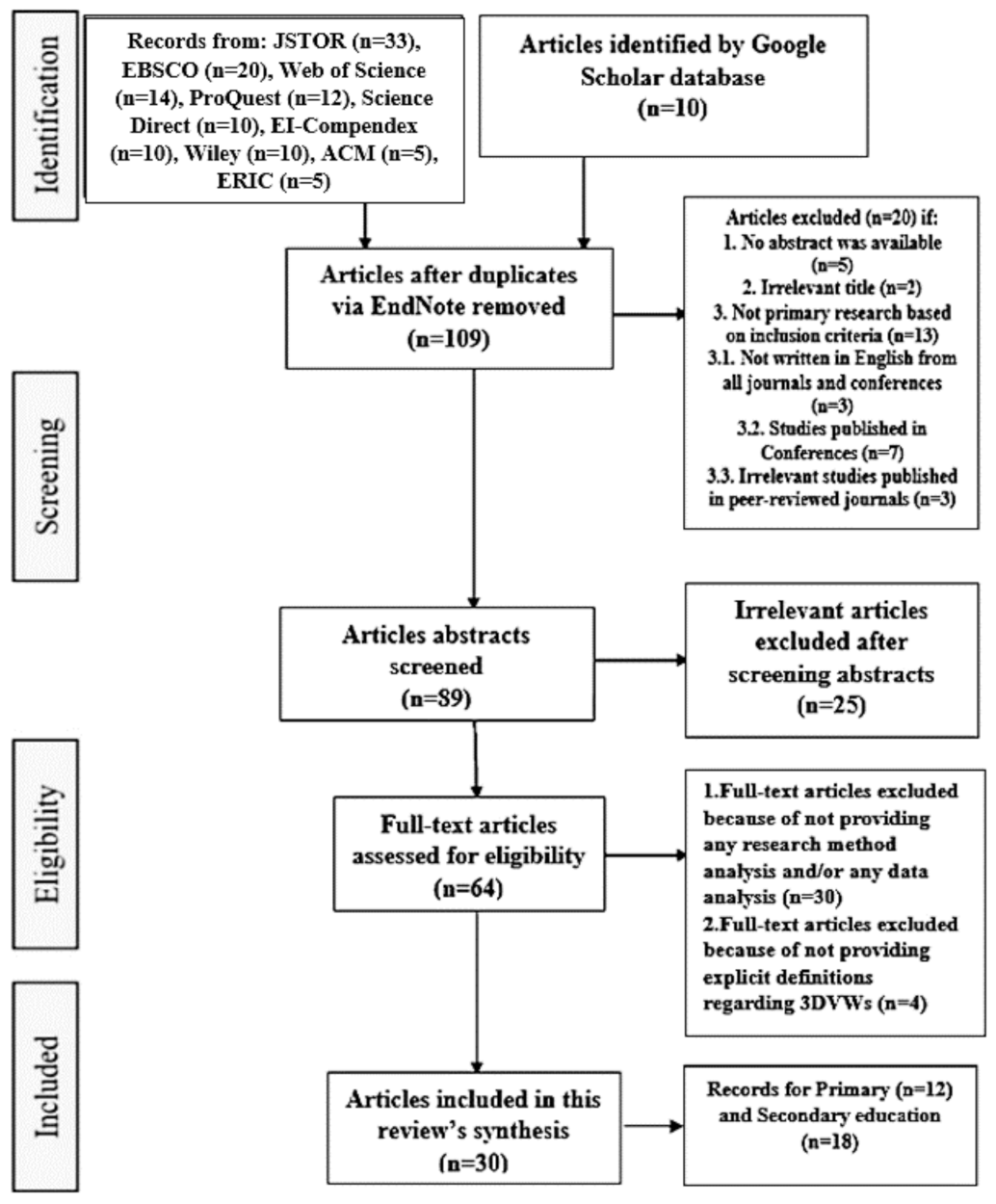
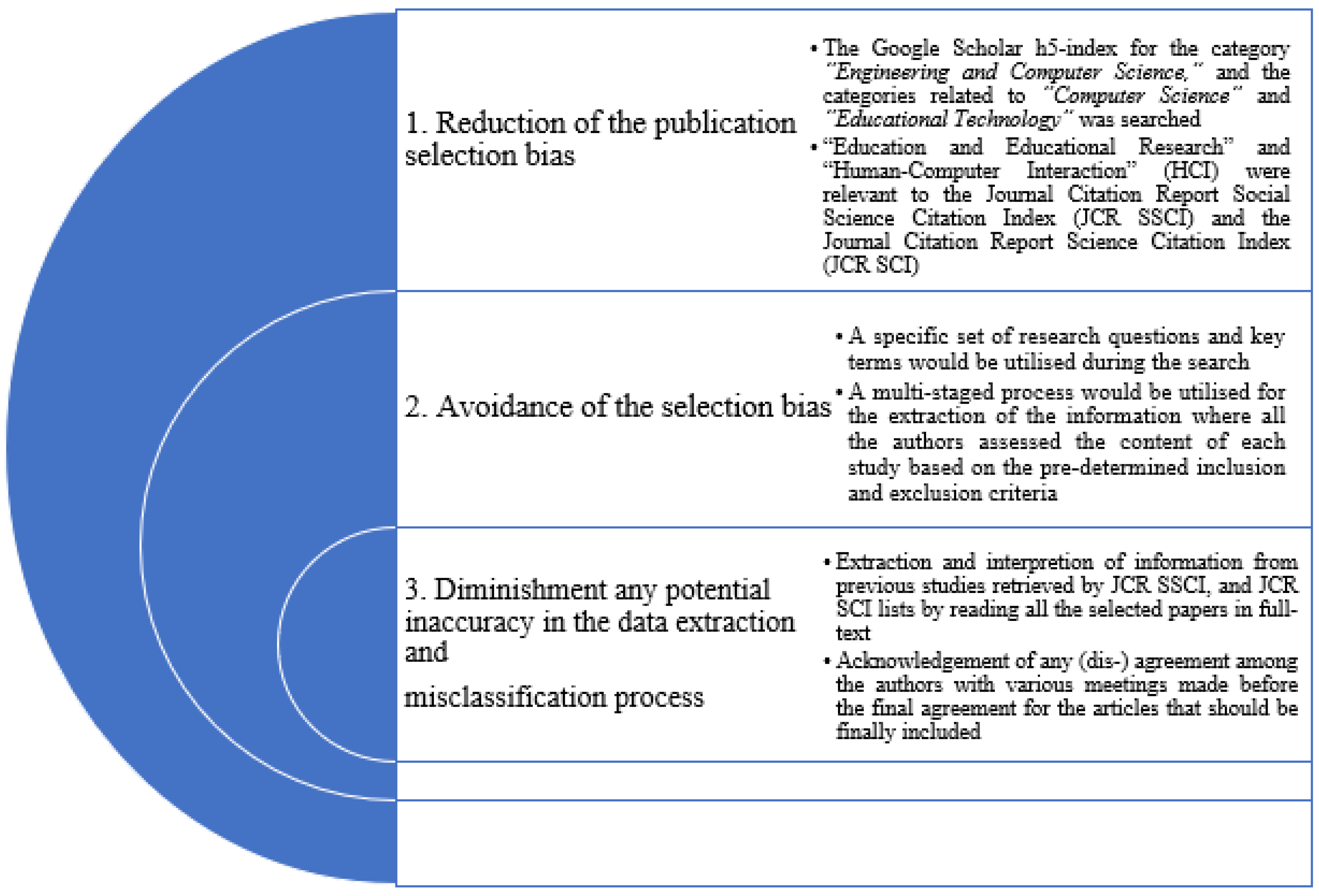
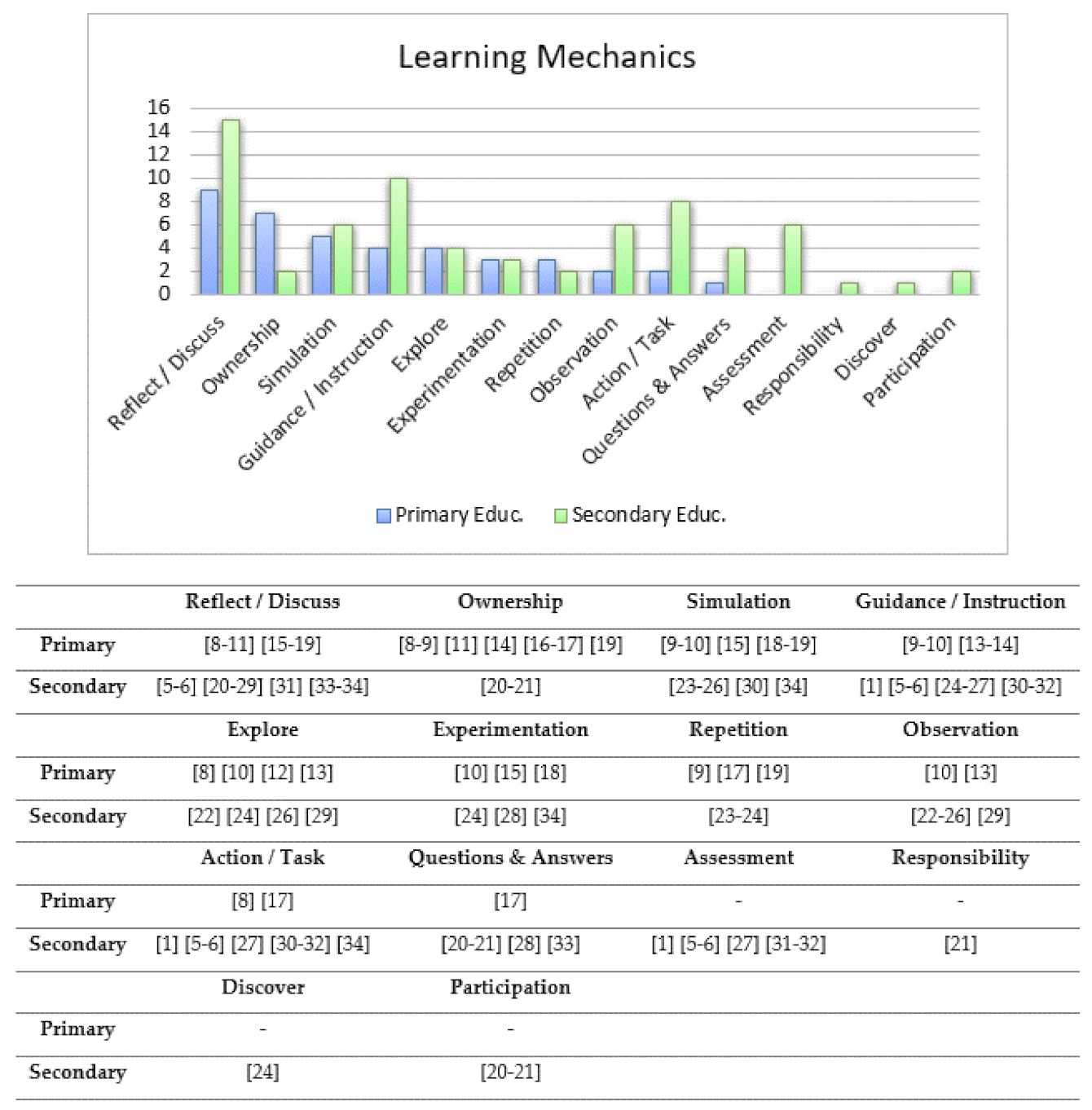
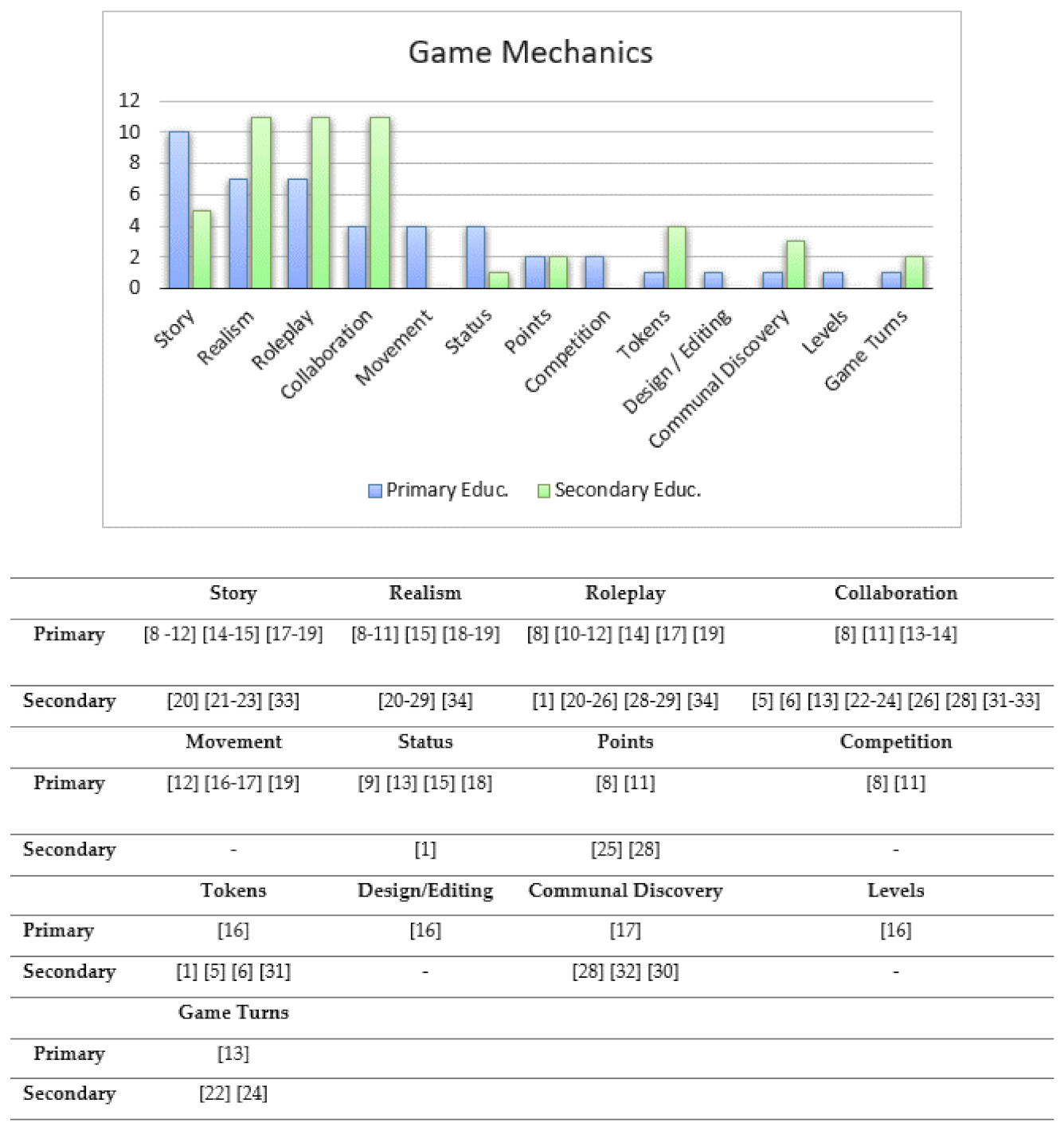
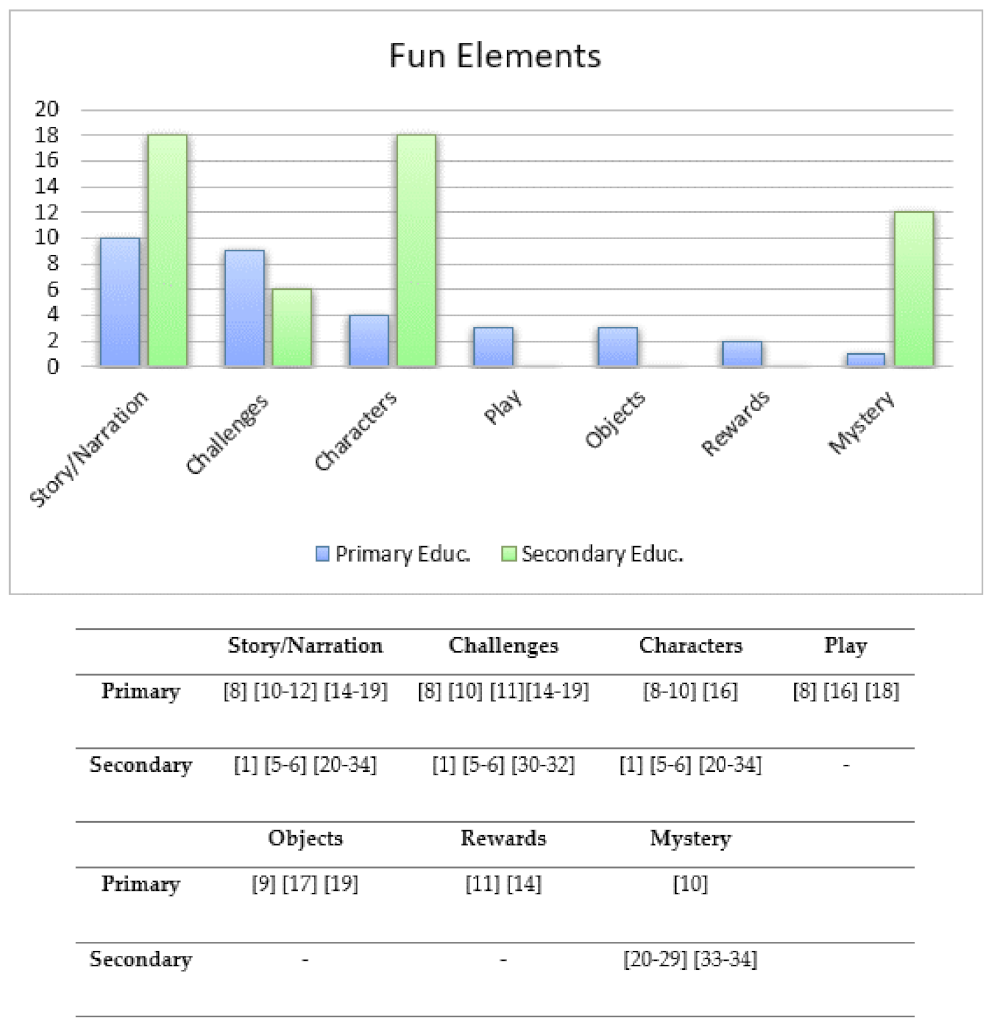
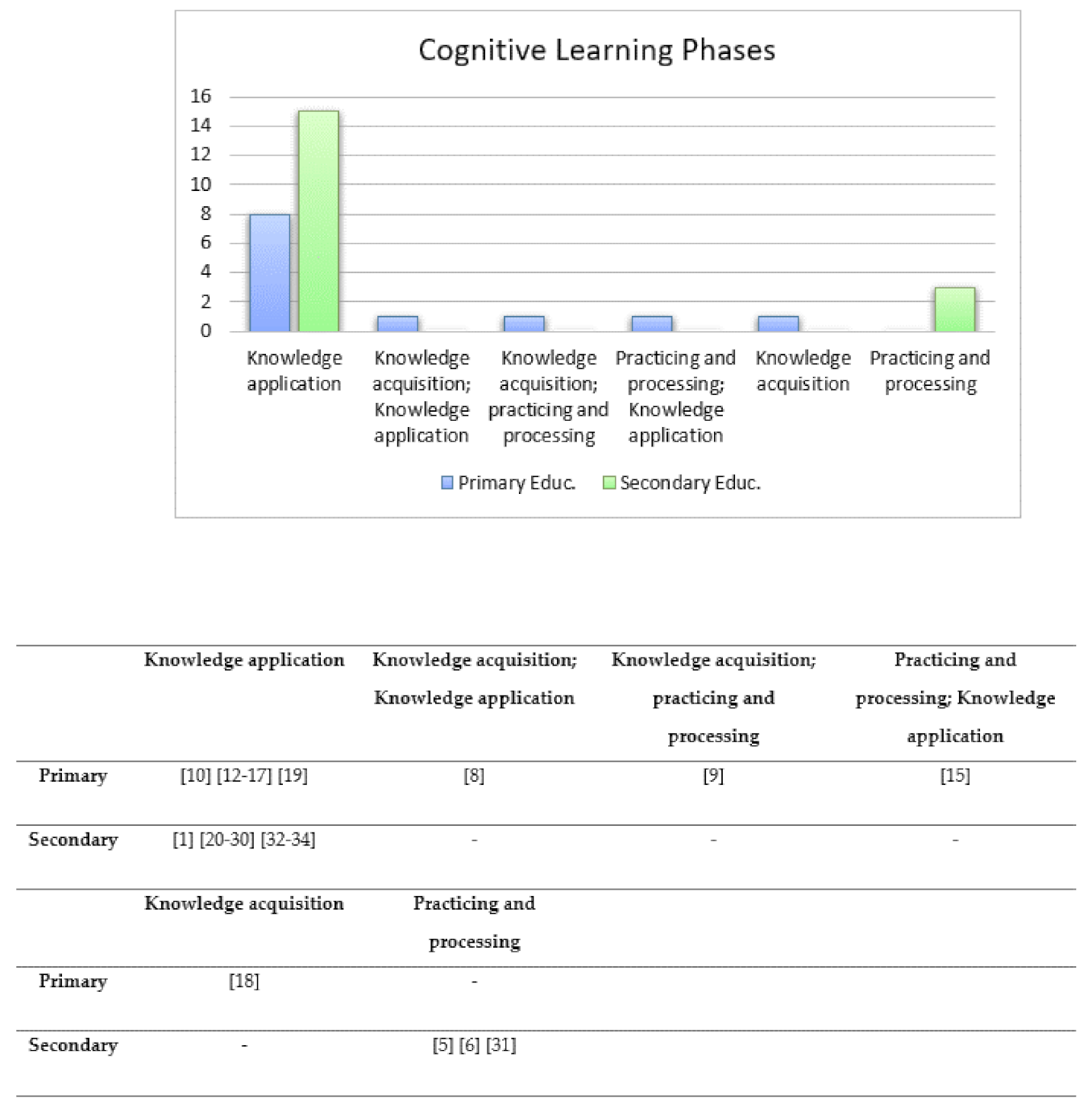

| (“Virtual Worlds*” OR “3D Virtual Worlds”) AND (“Science*”) (“Technology”) (“Engineering*”) (“Mathematics”) (“Language Learning*”) (“Computer Science”) (“History”) AND (“Child-Computer Interaction*”) (“Primary education*” OR “Secondary education”) (“Virtual Worlds*” OR “3D Virtual Worlds”) (“Engineering*”) (“Mathematics”) (“Language Learning*”) (“Computer Science”) (“History”) |
| Criteria | Inclusion | Exclusion |
|---|---|---|
| Time | December 2006 to December 2020 | Studies outside these dates |
| Language | English | Non-English articles |
| Type of articles | Original research, published in international peer-reviewed journals | Articles that were not well-documented in terms of using 3DVWs or other articles published in editorials/opinion works or in conferences |
| Type of method | Qualitative and/or quantitative or mixed | No method described |
| Study focus | Articles where their overwhelming theme related to Primary and Secondary (K-12) instructional design contexts supported by 3DVWs | Articles which have not well-documented the use of 3DVWs in (in-)formal contexts |
| Sample | K-12 students | Higher education, P-12, and Pre-service students |
| Study concept | All K-12 subjects | Articles that did not refer anything on what subject a 3DVW was utilised |
| Criteria | Response Grading | Percentage Acceptance of the Included Articles |
|---|---|---|
| 1. Are the research questions and objectives of this study clearly defined? | [1, 0.5, 0] (Yes, Nominally, No) | 81% |
| 2. Does this study’s context address the main research adequately? | [1, 0.5, 0] (Yes, Nominally, No) | 79% |
| 3. Are the results clearly stated? | [1, 0.5, 0] (Yes, Nominally, No) | 78% |
| 4. Can this study’s results provide valuable information? | >80% = 1, <20% and in-between = 0.5 | 88% |
| Primary Education | Secondary Education |
|---|---|
| Multiplayer: Taking advantage of the affordance that 3DVWs have so as to structure interest-driven shared spaces in which users can occupy the same environment and generate visual effects (e.g., [8,17]). | Multiplayer: Having a partner to perform unusual tasks (e.g., travel in time, solve mysteries) and communicate ideas can boost students’ confidence and Forster their critical thinking (e.g., [20,24]). |
| Single-player: Each student can become the in-game central figure and ne ready to succeed in a number of challenges by identifying sub-parts of a problem, analyze the problem0solving context, collect evidence, hypothesise and finally experiment to generate possible solutions (e.g., [1,13,14]) | Single player: Computer-based agents (puppeteers) provide a great alternative to populate 3DVWs with virtual inhabitants (social characters), increasing students’ interest towards the subject and support the learning process (e.g., [27,30]). |
| Collaboration: Working in pairs or with their peers to analyze tasks, users can discuss and/or negotiate at the same time and environment possible solutions to succeed specific learning objectives (e.g., [5,19]). | Competitiveness: A game, be it leisure or educational, have a ludic and amusing nature. Nonetheless, competitiveness is also an inherited element that can be found in most modern games. Thence, providing users with the right incentives to compete each other (e.g., awards, trophies) can greatly impact their motivation and engagement (e.g., [1,4]). |
| Linear events: Students are engaged in pre-defined activities and perform a series of tasks that can be sequentially organized (e.g., [13,14]). | Linear events: the order of the provided information, guidelines and virtual tasks should always be consistent with the order of the hypotheses that the students are examining in each time (e.g., [22,28]). |
| Non-linear events: the organized presence of multiple data sources, evidence, exhibits and learning paths (e.g., [10,18]). | Non-linear events: Offering users multiple alternate paths and freedom to choose or take complete control over the game scenario can help them in developing deeper understanding (learn by their mistakes) and cause emotional regulation (e.g., [20,24]). |
| Context-aware: Users within context-aware can collaborate and study together using contextual information, such as data visualization tools [21] and concept mapping [27]. |
| Primary Education | Secondary Education |
|---|---|
| Learning within curriculum-aligned tasks can assist students to actively engage in “learn by doing” tasks and easily study any subject area. To this end, students’ interest is increased in a subject area and thus enhance their initiatives, when they can explore and experiment with virtual objects [4]. | The knowledge construction should not be limited by the “borders” of a 3D VW. Therefore, there should be not all the game objectives announced at the beginning. Instead, a “hybrid” learning scenario, where students collect information from external sources and undertake activities in both environments (i.e., physical and virtual) should be considered as appropriate option [6,35]. |
| The activation of students’ agency through meaningful choices reflecting on their autonomy is beneficial for their engagement. Multiple choices in-game can invoice isolated gaming aspects, such as avatars [10] either influence decisively a learning path [12] | Students should have enough freedom to choose their learning path. This may extend further students’ initiatives to explore a gaming environment and to interact with other peers or learning objects to learn how to collect information and understand further visual object created into 3DVWs [24,30]. |
| Collaborative activities in 3DVWs enhance students’ cognitive engagement and critical discourse with academic content and subject skills as well as improving largely their satisfaction [13]. | Integrating tools to identify students’ emotional and cognitive states can enable educators and instructional designers to promote competencies (e.g., scientific problem-solving tasks) better and improve the learning assessment focus [28]. |
| The students’ learning performance and achievements can be amplified in gaming. Thence, students need to formulate and test hypotheses through experimentation and spaced practice repetition [11,14]. | User design features and elements with natural intuitive modality can be used to engage especially high school students into realistic problem-solving learning conditions. Another relevant condition, which is also relevant, is the simulation of embodied experiences via avatars to serve their ideas like in real life [4,20]. |
Publisher’s Note: MDPI stays neutral with regard to jurisdictional claims in published maps and institutional affiliations. |
© 2021 by the authors. Licensee MDPI, Basel, Switzerland. This article is an open access article distributed under the terms and conditions of the Creative Commons Attribution (CC BY) license (https://creativecommons.org/licenses/by/4.0/).
Share and Cite
Pellas, N.; Mystakidis, S.; Christopoulos, A. A Systematic Literature Review on the User Experience Design for Game-Based Interventions via 3D Virtual Worlds in K-12 Education. Multimodal Technol. Interact. 2021, 5, 28. https://doi.org/10.3390/mti5060028
Pellas N, Mystakidis S, Christopoulos A. A Systematic Literature Review on the User Experience Design for Game-Based Interventions via 3D Virtual Worlds in K-12 Education. Multimodal Technologies and Interaction. 2021; 5(6):28. https://doi.org/10.3390/mti5060028
Chicago/Turabian StylePellas, Nikolaos, Stylianos Mystakidis, and Athanasios Christopoulos. 2021. "A Systematic Literature Review on the User Experience Design for Game-Based Interventions via 3D Virtual Worlds in K-12 Education" Multimodal Technologies and Interaction 5, no. 6: 28. https://doi.org/10.3390/mti5060028
APA StylePellas, N., Mystakidis, S., & Christopoulos, A. (2021). A Systematic Literature Review on the User Experience Design for Game-Based Interventions via 3D Virtual Worlds in K-12 Education. Multimodal Technologies and Interaction, 5(6), 28. https://doi.org/10.3390/mti5060028








